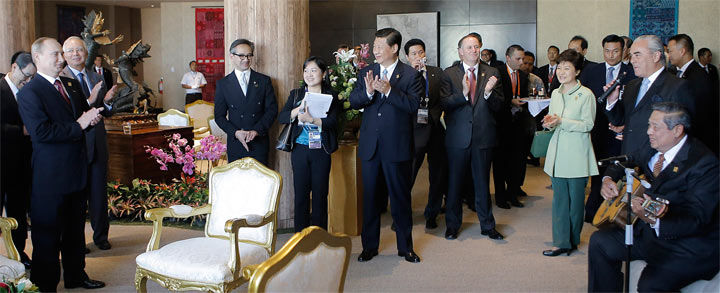Shootout at the APEC Free-trade Corral
What a photo – yet another instance of Bali working its magic. Chinese President Xi Jinping leads a “Happy Birthday” for Russian President Vladimir Putin, with Indonesian President Susilo Yudhoyono on acoustic guitar.
You know who is not in the picture – he’s in shutdown containment mode. US Think Tankland protestations notwithstanding, there could not be a more graphic reminder of the emerging multipolar order.
And right on cue, the Creditor, somewhat alarmed, pointedly reminded the massive Debtor, via Chinese vice-finance minister Zhu Guangyao: “As the world’s largest economy and the issuer of the major reserve currency in the world, it is important for the US to maintain the creditworthiness of its Treasury bonds.” [1]
Translation; just as Asia-Pacific gathered to discuss the messier points of economic cooperation at the Asia Pacific Economic Cooperation (APEC) summit in Bali, what everybody was worried about is the scary possibility of the US government defaulting on its colossal debts next week.
All this interfered with by a sideshow – the Return of the Extraordinary Rendition in Libya and Navy SEALS getting their butts kicked by a bunch of al-Shabaab jihadis in Somalia, more than enough to bury any coverage of the APEC summit by US corporate media.
As predicted, China was the star of the APEC show. It’s never enough to remember that the 21-member APEC accounts for no less than half of the globe’s economic output and trade. Xi insisted APEC should lead and coordinate the maze of free trade negotiations in Asia-Pacific.
He also insisted that any trade agreement should be “inclusive” – as in including China. Only then would it bear the requisite “win-win” trademark; as if Xi needed to emphasize once more – as he did – that China is the biggest trading partner and export market for virtually every Asia-Pacific nation.

Behold the “Diamond Decade”
The ongoing blockbuster in Asia-Pacific is the clash of the FTAs; there are a dizzying, over 100 competing free-trade agreements currently in play. Negotiations at the World Trade Organization are, to put it mildly, a mess.
So a lot of players resort to bilateral and somewhat multilateral FTAs. Overall, the top contenders are the 16-nation, ASEAN-led Comprehensive Economic Partnership (which includes China) and the 12-nation, US-led Trans-Pacific Partnership (TPP), which excludes China..
Xi stressed over and over again that China favors one FTA to cover all of the Asia-Pacific. And as far as Beijing is concerned, that won’t be TPP – which is essentially a major US corporate racket that will lower tariffs across the spectrum to the sole benefit of US multinationals and not small and medium-sized firms in developing countries, all this under the cover of a dodgy “highest free trade standard”.
China essentially wants APEC to put order in the court. Obama has been too busy pivoting to himself instead of pivoting to Asia, more specifically Bali, to offer his spin – but the fact is Washington wants to ram up a TPP over its “partners” under a tight deadline, the end of 2013, glossing over key “devil in the details” discussions over market access (sweet if you’re a corporate behemoth) and intellectual property (corporate behemoths marketizing everything).
It gets curioser and curioser when one is reminded that APEC at the beginning was very much a US Asia policy stalwart. I vividly remember covering the APEC summit in Bogor, Indonesia in 1994 – when an undisputed Bill Clinton seemed to be dictating the future of Asia-Pacific.
That was a sort of “pivoting to Asia” before the fact – and totally under American terms. Then, after the pivoting was first announced by then US secretary of state Hillary Clinton in 2011, she spun it as the dawn of “America’s Pacific century”.
This “Pacific century” seems to boil down, so far, to enforcing an already embattled TPP. Bantarto Bandoro, from the Indonesian Defense University, seemed to get closer to the real picture when he told the Jakarta Globe, “this could be the beginning of the end of American global dominance.”
While the verdict in this Shootout at the Free Trade Corral remains open, workaholic China proceeds.
After its spectacular New Silk Road successes in Central Asia, Beijing has just proposed a – what else is new – Maritime Silk Road (MSR) in Southeast Asia, boosting trade between China and ASEAN.
Once again, Xi was the messenger, in his current tour of Indonesia and Malaysia; he beamed that the MSR would turn the “Golden Decade” between China and ASEAN into a “Diamond Decade”. China is the 10-member ASEAN’s largest trading partner (over US$400 billion in 2012), with mutual investment at over $100 billion and growing.
Beijing sees this coming “Diamond Decade” as the bulk of the political/economic solution for the so far intractable territorial problems in the South China Sea, which pit China against four ASEAN members; Vietnam, Philippines, Malaysia and Brunei.
Xi already embarked on a charm offensive in Malaysia, and it’s unclear what Vietnam and the Philippines will make of this “Diamond Decade” when there’s so much unexplored, unassigned oil and gas to be found in the South China Sea.
Yet once again, Beijing is playing the long game. The 2014 APEC summit will be held – of all places – in Beijing. By then Obama may have found time to do some actual pivoting. And by then that may be too little, too late.
Pepe Escobar is the author of Globalistan: How the Globalized World is Dissolving into Liquid War (Nimble Books, 2007), Red Zone Blues: a snapshot of Baghdad during the surge (Nimble Books, 2007), and Obama does Globalistan (Nimble Books, 2009).
He may be reached at pepeasia@yahoo.com.
Note:
1. China urges US to prevent debt default, Xinhuanet, October 7, 2013.
Copyright 2013 Asia Times Online (Holdings) Ltd
See also –
Indonesian president sings to Putin: Russian President Vladimir Putin has celebrated turning 61 by quaffing vodka, wolfing down cake and being serenaded by some of the world’s most powerful men.
